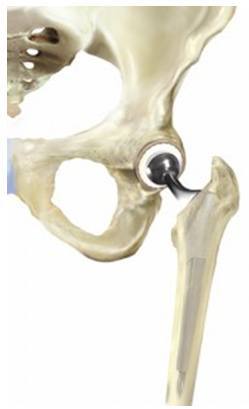Posterior Approach Total Hip Replacement

A total hip replacement involved removing the existing arthritis and placing a metal cup in the socket and a metal stem down the femur. There is a plastic, polyethylene, liner that is placed between the ball and the socket to provide a non metal-on-metal weight bearing surface.
Posterior-Approach Hip Replacement
Posterior hip replacement is a minimally-invasive hip surgery performed to replace the hip joint. The posterior approach is traditionally the most common approach used to perform total hip replacement. In the posterior approach, the surgeon makes an incision at the back of the hip close to the buttocks.
Indications
Hip replacement is indicated in patients with arthritis of the hip joint. Arthritis is a condition in which the articular cartilage that covers the joint surface is damaged or worn out causing pain and inflammation. Some of the causes of arthritis include:
- Advanced age
- Congenital or developmental hip diseases
- Obesity
- Previous history of hip injury or fracture
- Increased stress on hip because of overuse
Procedure
- The procedure is performed under general anesthesia.
- You will lie on non-affected hip side enabling access to the posterior aspect of your hip
- An incision is made on the posterior aspect of your hip close to your buttocks
- Once the hip is accessed and the artificial implants are in place, all soft tissues are re-approximated, and the incisions are closed with sutures and covered with a sterile dressing
- You will be placed with an abduction pillow between your legs to protect our soft-tissue repair
- You can start walking immediately after surgery
Postoperative Care
After posterior-approach hip replacement surgery, you will be instructed to follow certain hip precautions to prevent your new hip from dislocating. These guidelines include not bending or flexing the hip past 90 degrees, no crossing of legs, and no rotating of the operating leg inwards.
Your doctor will also give you other instructions to follow at home for a faster recover. These include:
- Take medications as prescribed to relieve pain and prevent infection
- Participate in physical therapy to restore hip function and strength
- Eat a healthy diet and do not smoke to facilitate healing, prevent infection, and promote a faster recovery
Dr. Gupta to give a lecture series at Georgetown yoga "Healthy Movements Workshop" focused specifically on hip, knee, and shoulder injury prevention and those patients with existing injuries in April and May.
Dr. Gupta is now "board certified" in Orthopedic Surgery.
Dr. Gupta to present Orthopedic Lecture Series with Sentara Northern Virginia Medical Center titled "Don't Let Hip Pain Slow You Down: Understanding Your Options", September 7th, 2016 at Hilton Garden Inn Woodbridge at 6pm.
Dr. Gupta to present third part of his lecture series on "Master Mobility" at Spark Yoga. His next lecture with be on "Mastering Mobility Of Your Knees" on September 18th at The Shops at Pershing, 2201 N Pershing Dr, Arlington, VA 22201










